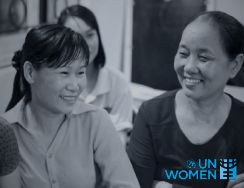Lao PDR
| Date of Accession/ Ratification: | 17 July 1980 (signed), 14 Aug 1981 (ratified) |
| Reservations: | None |
| Optional Protocol: | Not signed |
| Reporting Status: | - Initial, 2nd, 3rd, 4th and 5th combined reports examined at 32nd Session, January 2005 - Combined 6th and 7th reports examined at 44th Session, 2009 - 8th and 9th combined report due September 2014; Written information on VAW and migrant women workers due 2011 |
| Shadow reports | Situation of rural women in Lao PDR, submitted by International Women’s Rights Action Watch Asia Pacific (IWRAW Asia Pacific) |
| Concluding Observations | Concluding observations from 44th session |
| Follow-up reports | State response to Concluding Observations |
| Coordinating Agency for CEDAW implementation: | National Commission for the Advancement of Women (Lao NCAW); Lao Women’s Union (LWU); National Assembly Ministry of Justice |
The Lao People’s Democratic Republic (Lao PDR) is a landlocked country in Southeast Asia, bordered by China, Myanmar, Viet Nam, Cambodia and Thailand. After gaining independence in 1954 as a constitutional monarchy, years of civil war followed that saw the monarchy overthrown by communist forces in 1975. Political power today rests with the Lao People’s Revolutionary Party (LPRP), the only legal political party in the nation. Despite this, Lao PDR remains one of the region’s poorest countries. It continues to be ranked among the least developed countries (LDCs) of the world – a status the government has pledged to change by 2020. Since ratifying CEDAW in 1981, and based on the achievements of their last reporting session to the CEDAW Committee, Lao PDR has adopted its second National Strategy on the Advancement of Women for 2011-2015 which outlines its political commitment to CEDAW.
| Ratified international human rights treaties | |
|
|
Figure 1 Ratification of international human rights treaties acknowledged
in the 2009 Concluding Observations
However, poverty continues to ensue, and almost a fourth of the population lives below the national poverty line ($0.96USD) and ranks 138 of 187 countries on the Human Development Index which falls below the medium human development average. This further impacts the migration of people in which 80 percent who live in rural areas are affected and thus migrate to urban centres or across borders seeking work.[2] These communities who perform agricultural activities, are also impacted by climate change which hinders any form of sustainable development, and there is a lack of basic infrastructure and services, where women in rural and remote areas are most vulnerable to human rights violations. Women within rural and remote areas are further disadvantaged due to food shortages, illiteracy, difficulties in accessing health, education and social services, and a lack of political participation at community levels.
| Multidimensional Poverty Index Rank – MPI – (of 104 countries) – ‘head count’ (%) | From 2006 survey: 56.5 |
| Gender Inequality Index Rank – GII – (of 148 countries) | In 2012: 100 |
| Social Institutions and Gender Index – SIGI | In 2009: 38 (of 102 countries) In 2012: 49 (of 86 countries) |
Unclear mandates, low levels of coordination and a lack of sufficient budget allocations have also deterred Lao PDR from advancing women’s rights within policy-making and implementation. Women’s roles and duties in society continue to be stereotyped, especially among ethnic communities where they endure negative traditional practices.
Some offenders of violent acts against women who conduct ‘less harmful acts’ as opposed to ‘seriously harmful’ are exempted from penal liabilities. Women and especially girls between 12 and 18 years of age are often subjected to urban and rural trafficking, while there is limited data on vulnerable groups such as the elderly or disabled. More information at CEDAW in Action - Lao PDR.
Supported by:
Latest news
At a glance

Getting to know more about CEDAW and the Regional Programme in Southeast Asia | CEDAW Brochure